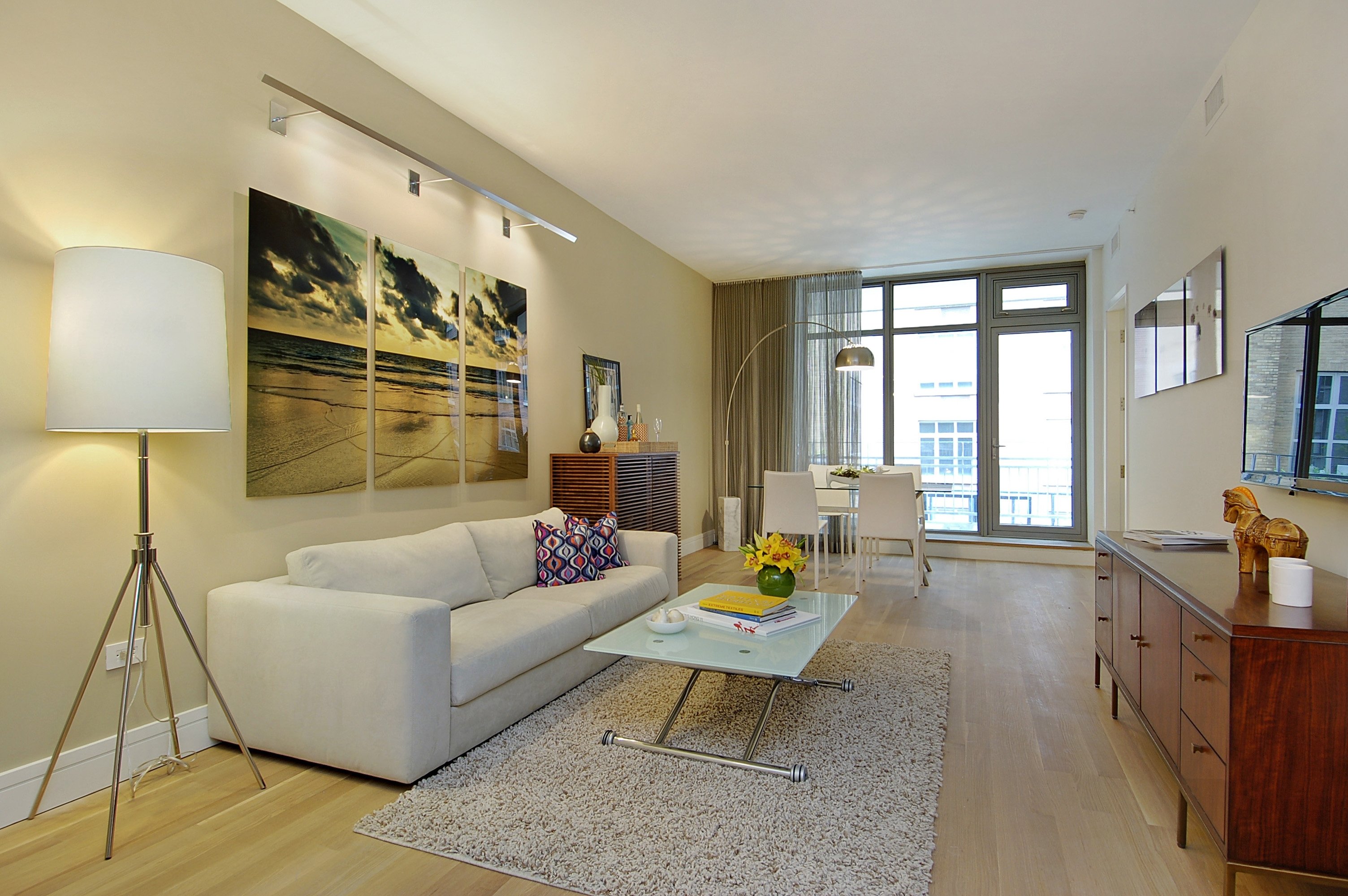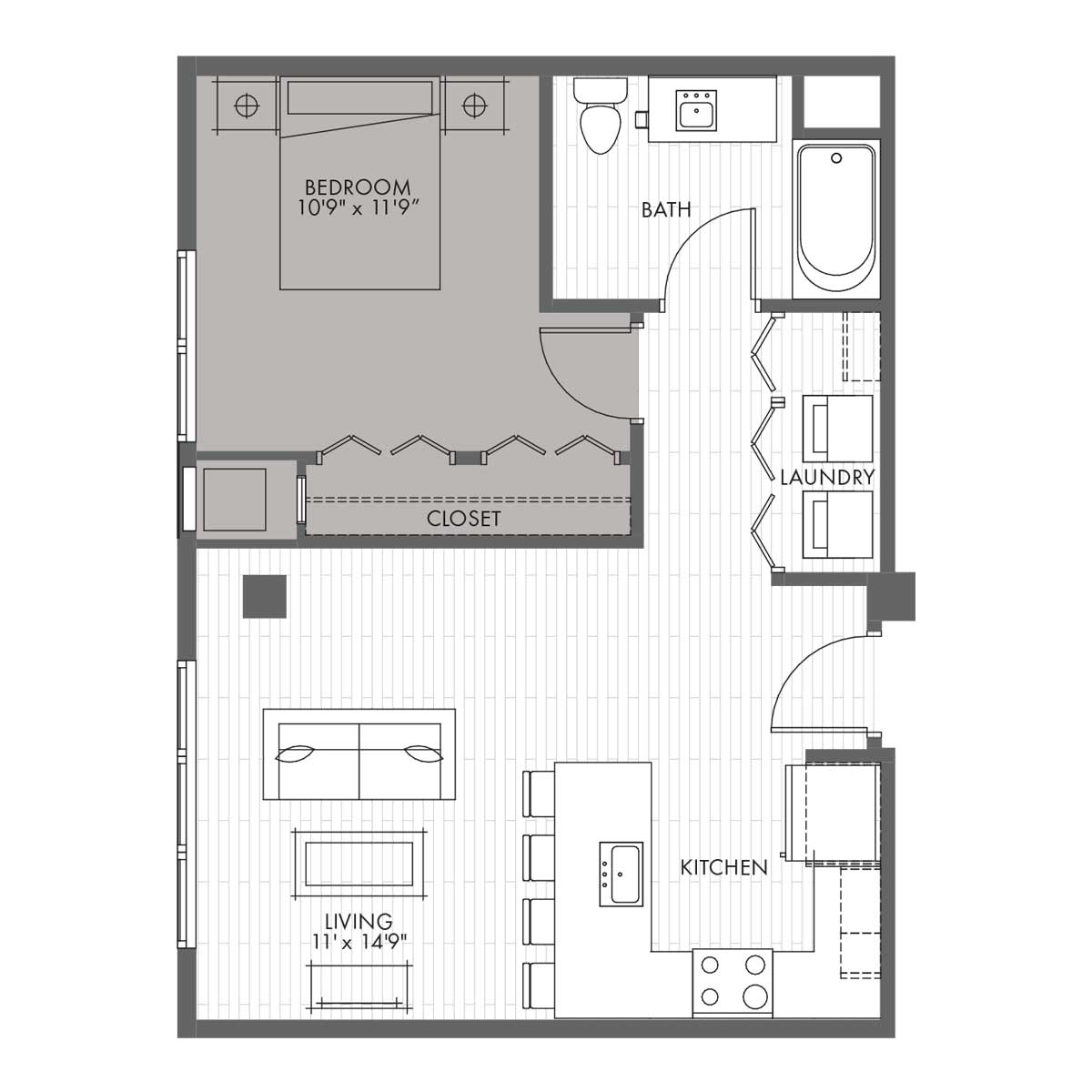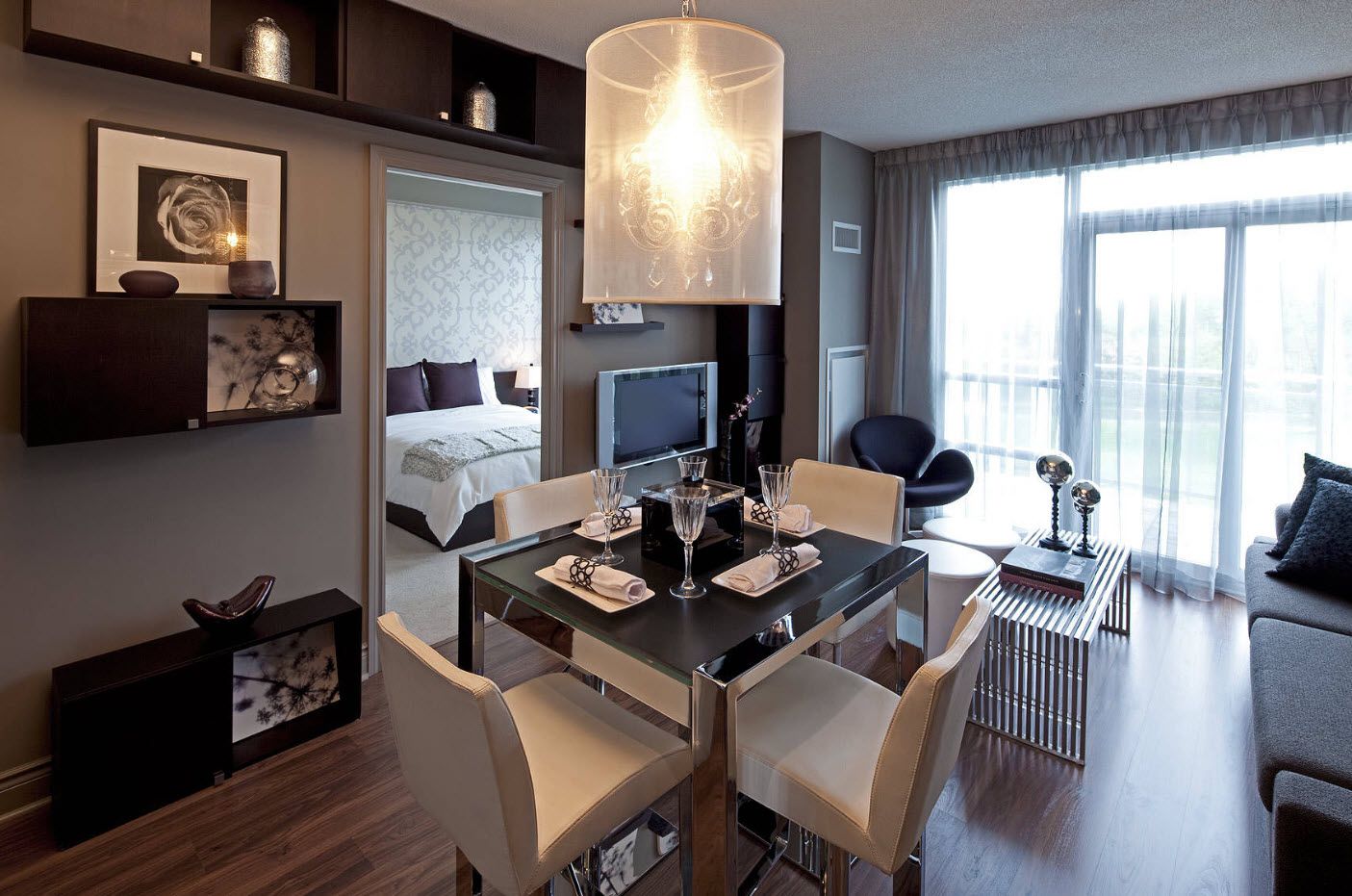Design Considerations for a One-Bedroom Self-Contained Plan

Creating a functional and stylish one-bedroom self-contained unit requires careful planning and design. This type of living space presents unique challenges, demanding efficient use of every square foot.
Essential Elements of a One-Bedroom Self-Contained Unit
A well-designed one-bedroom self-contained unit should include a balanced blend of essential elements that cater to functionality and comfort. These elements ensure that the space meets the diverse needs of its inhabitants.
- Living Area: A designated space for relaxation, entertainment, and social gatherings. This area should be comfortable and inviting, accommodating seating, a coffee table, and potentially a TV.
- Kitchenette: A compact kitchen area equipped with essential appliances like a stovetop, microwave, refrigerator, and sink. This area should be well-organized and efficient, maximizing space for cooking and food preparation.
- Sleeping Area: A dedicated space for sleep and rest, ideally separated from the living area for privacy. This area should be calming and conducive to restful sleep, featuring a comfortable bed, bedside table, and potentially a wardrobe or storage solutions.
- Bathroom: A private space with a shower, toilet, and sink. The bathroom should be designed for optimal hygiene and comfort, with sufficient storage for toiletries and towels.
- Storage Solutions: A well-designed one-bedroom self-contained unit should incorporate ample storage solutions to minimize clutter and maintain a sense of order. This includes built-in cabinets, shelves, drawers, and potentially a closet or storage unit.
Space Optimization Strategies
Maximizing space efficiency is crucial in a one-bedroom self-contained unit. Implementing smart design principles can transform a small space into a comfortable and functional living environment.
- Open Floor Plans: Open floor plans can create a sense of spaciousness by eliminating physical barriers between different areas. This design strategy allows natural light to flow freely throughout the unit, enhancing the overall feeling of openness.
- Multifunctional Furniture: Choosing furniture with multiple functions can help save valuable space. For example, a sofa bed can serve as both seating and a sleeping surface, while a coffee table with storage can provide additional space for books and other items.
- Vertical Storage: Utilizing vertical space for storage is a highly effective way to maximize space efficiency. This includes installing shelves, cabinets, and other storage solutions that reach towards the ceiling, freeing up valuable floor space.
- Built-in Solutions: Built-in storage solutions, such as cabinets, shelves, and drawers, are designed to fit seamlessly within the unit’s structure, maximizing space efficiency. These solutions eliminate the need for bulky freestanding furniture, contributing to a cleaner and more organized look.
Layout Options for One-Bedroom Self-Contained Plans, One bedroom self contain plan
Various layout options can be considered for a one-bedroom self-contained unit, each offering unique advantages and disadvantages.
- Open Plan: This layout combines the living, dining, and kitchen areas into one open space, maximizing natural light and creating a sense of spaciousness. However, it can be challenging to define distinct zones and maintain privacy.
- Linear Layout: This layout arranges the living, dining, and kitchen areas in a straight line, often with the bedroom at the end of the unit. This design offers a clear flow and distinct zones but may feel less spacious than an open plan.
- L-Shaped Layout: This layout positions the living, dining, and kitchen areas in an L-shape, creating a defined living area and a separate kitchen space. This design offers a good balance of openness and separation, but it can be challenging to maximize space efficiency.
Importance of Natural Light and Ventilation
Natural light and ventilation are crucial for creating a healthy and comfortable living environment in a self-contained unit.
- Maximize Natural Light: Utilize large windows to allow ample natural light to flood the space. Consider strategically placing mirrors to reflect light and enhance the feeling of spaciousness.
- Promote Ventilation: Ensure adequate ventilation by installing exhaust fans in the bathroom and kitchen. Open windows regularly to allow fresh air to circulate, especially after cooking or showering.
Essential Features and Amenities: One Bedroom Self Contain Plan

A one-bedroom self-contained unit offers a complete living space within a compact footprint. This typically includes a kitchen, bathroom, and living area, all designed to maximize functionality and comfort. These essential features cater to a range of needs, providing a self-sufficient living environment.
Kitchen Design in Compact Spaces
Creating a functional kitchen within a small space requires thoughtful planning and efficient use of available area. Key considerations include appliance choices, storage solutions, and layout optimization.
A well-designed kitchen in a one-bedroom unit should prioritize functionality and efficiency. Here are some essential considerations:
- Appliance Choices: Opt for compact appliances like a microwave oven, a small refrigerator, and a two-burner cooktop. These appliances save space without compromising on functionality.
- Storage Solutions: Utilize vertical space with wall-mounted shelves, cabinets, and organizers. Maximize counter space with pull-out drawers and organizers to store frequently used items.
- Layout Optimization: Consider a galley kitchen layout, which maximizes space efficiency by placing appliances and cabinets along two parallel walls.
Designing a Comfortable Living Area
The living area is the heart of a one-bedroom unit, serving as a space for relaxation, entertainment, and socializing. It should be designed to create a comfortable and inviting atmosphere, while maximizing space utilization.
- Seating: Choose multi-functional furniture like a sofa bed that provides both seating and sleeping space. Consider using ottomans or poufs for additional seating and storage.
- Storage: Incorporate built-in shelving, cabinets, or storage ottomans to minimize clutter and create a sense of spaciousness.
- Entertainment: A wall-mounted flat-screen television or a compact entertainment system can provide entertainment options without taking up valuable floor space.
Bathroom Design for Functionality and Aesthetics
A well-designed bathroom in a one-bedroom unit should be both functional and aesthetically pleasing. It should prioritize space optimization, storage solutions, and a comfortable and relaxing atmosphere.
- Functionality: Choose a compact shower stall or a bathtub with a shower head to save space. A pedestal sink or a wall-mounted vanity can further maximize floor space.
- Storage: Utilize wall-mounted shelves, cabinets, or a medicine cabinet to store toiletries and towels.
- Aesthetic Appeal: Use light colors and natural materials to create a sense of spaciousness and tranquility. A small window or a skylight can provide natural light and ventilation.
Construction and Building Materials

Building a one-bedroom self-contained unit involves careful consideration of construction methods and building materials. The choices you make will significantly impact the cost, durability, sustainability, and overall appeal of your project. This section delves into the intricacies of construction techniques, material selection, and energy efficiency considerations for a self-contained unit.
Construction Methods
The choice of construction method depends on various factors, including budget, desired timeframe, and the complexity of the project. Here are some popular methods suitable for one-bedroom self-contained units:
- Traditional Construction: This method involves using traditional materials like bricks, concrete, and timber. It is a robust and durable option but can be time-consuming and labor-intensive, making it potentially more expensive. Traditional construction offers flexibility in design and allows for customization, making it suitable for unique architectural features.
- Prefabricated Construction: This method utilizes pre-made components manufactured off-site and assembled on the building site. Prefabricated construction is faster, more efficient, and often more cost-effective than traditional methods. However, it may offer less design flexibility compared to traditional construction. Prefabricated units are often designed for ease of assembly and can be customized to some extent.
- Modular Construction: This method involves building the unit in modules, which are pre-designed and manufactured off-site. These modules are then transported to the site and assembled quickly. Modular construction offers similar benefits to prefabricated construction, including speed and cost-effectiveness, while providing greater design flexibility. It is particularly suitable for complex designs and multi-story buildings.
Building Material Selection
Selecting the right building materials is crucial for ensuring durability, sustainability, and aesthetic appeal. Here are some common building materials used in self-contained units:
- Concrete: Concrete is a durable and versatile material often used for foundations, walls, and floors. It offers excellent strength and fire resistance. However, concrete can be heavy and requires specialized labor for installation.
- Timber: Timber is a renewable and sustainable material often used for framing, flooring, and roofing. It offers excellent insulation and aesthetic appeal. However, timber is susceptible to moisture damage and requires proper treatment for longevity.
- Steel: Steel is a strong and durable material often used for structural components, framing, and roofing. It is resistant to fire and pests but can be susceptible to corrosion. Steel is also a good conductor of heat, so insulation is important for energy efficiency.
- Brick: Bricks are durable and aesthetically pleasing, often used for exterior walls. They offer good insulation and soundproofing but can be labor-intensive to install. Bricks are also relatively heavy, requiring a strong foundation.
- Glass: Glass is a versatile material used for windows and doors. It allows natural light to enter the unit, improving energy efficiency. However, glass can be fragile and require careful installation to ensure proper insulation and weatherproofing.
Energy Efficiency
Energy efficiency is paramount in self-contained unit construction, reducing energy consumption and minimizing environmental impact. Here are some methods to achieve energy efficiency:
- Insulation: Proper insulation is essential for reducing heat loss in winter and heat gain in summer. This can be achieved by using insulation materials like fiberglass, cellulose, or foam in walls, ceilings, and floors. Insulation reduces the need for heating and cooling, leading to lower energy bills and a more comfortable living environment.
- High-Performance Windows: Double- or triple-paned windows with low-e coatings significantly reduce heat transfer, improving energy efficiency. These windows also reduce noise pollution, creating a quieter and more comfortable living space.
- Energy-Efficient Appliances: Choosing appliances with Energy Star ratings ensures they consume less energy, saving money and reducing your carbon footprint. This includes refrigerators, dishwashers, washing machines, and dryers.
- Renewable Energy Sources: Incorporating renewable energy sources like solar panels or wind turbines can significantly reduce your reliance on fossil fuels. Solar panels generate electricity from sunlight, while wind turbines harness wind energy. These options contribute to sustainability and lower energy costs over time.
Building Material Comparison
The following table compares commonly used building materials for self-contained units:
| Material | Advantages | Disadvantages | Concrete | Durable, fire-resistant, versatile | Heavy, labor-intensive, not as aesthetically pleasing as some other materials | Timber | Renewable, sustainable, good insulation, aesthetically pleasing | Susceptible to moisture damage, requires proper treatment | Steel | Strong, durable, fire-resistant | Susceptible to corrosion, good conductor of heat | Brick | Durable, aesthetically pleasing, good insulation and soundproofing | Labor-intensive to install, heavy, requires strong foundation | Glass | Allows natural light, improves energy efficiency | Fragile, requires careful installation for insulation and weatherproofing |
|---|
One bedroom self contain plan – So, you’re thinking about a one-bedroom self-contain plan, right? That’s a good start, but you’ll need to think about the furniture. If you’ve got a little one, you might be able to snag a bargain on a used kids bedroom set to save some cash.
Then, you can focus on getting the rest of your furniture sorted for your new digs.
So you’re thinking of getting a one bedroom self contain, right? That’s sick, mate! You’ll need some proper furniture to make it feel like home. Check out the liberty abbey park bedroom set – it’s got that chill vibe and will totally make your space look lush.
Once you’ve got the furniture sorted, you can start thinking about all the other things you need for your one bedroom self contain – like a decent telly and a sweet coffee machine.
